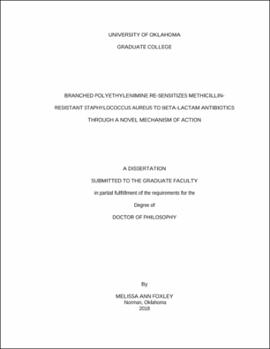| dc.description.abstract | Methicillin-resistant Staphylococcus aureus (MRSA) is a growing concern in the medical industry due to high morbidity and difficulty of treatment in infected patients. Conventional β-lactam antibiotics kill Staphylococcus aureus bacteria by inhibiting the function of cell-wall penicillin binding proteins (PBPs). However, β-lactams are ineffective against MRSA due to an extra PBP (PBP2a) that has a low binding affinity for β-lactam antibiotics. Branched polyethylenimine (BPEI), a non-toxic, cationic polymer, restores MRSA’s susceptibility to β-lactam antibiotics including oxacillin, ampicillin, imipenem, ceftizoxime, and piperacillin. Checkerboard assays with MRSA demonstrated synergy between BPEI and β-lactam antibiotics. BPEI and oxacillin were effective against MRSA USA300, MRSA MW2, MRSA 700787, and clinical isolates of MRSA. A time-killing curve showed BPEI in combination with oxacillin to be bactericidal. BPEI did not potentiate vancomycin, chloramphenicol, or linezolid against MRSA. Additionally, the BPEI:β-lactam efficacy was specific to MRSA and was not observed against methicillin-susceptible Staphylococcus aureus (MSSA), Gram-negative Escherichia coli, or Bacillus subtilis.
When exposed to BPEI, MRSA cells increased in size and had difficulty forming septa. Nuclear magnetic resonance (NMR) data show that BPEI alters the teichoic acid chemical environment, an anionic polymer found in the cell wall of Gram-positive bacteria. Laser scanning confocal microscopy (LSCM) images depict BPEI residing on the MRSA cell wall, where teichoic acids and PBPs are located. BPEI electrostatically binds to wall teichoic acid (WTA), a polymer that is important for localization of certain cell wall proteins. BPEI does not potentiate ampicillin or oxacillin when WTA is removed from the cell by genetic mutation or chemical inhibition of WTA synthesis. Using LSCM, we found that BPEI also prevents proper localization of PBP4, another PBP that aids in β-lactam resistance. Since PBP4 and PBP2a require WTA to properly localize in MRSA, in situ disabling of WTA using BPEI inhibits proper orientation and functioning of the enzymes. PBP2a requires teichoic acid to properly locate and orient the enzyme, and thus MRSA is susceptible to antibiotics that prevent teichoic acid synthesis in the bacterial cytoplasm. These data suggest that BPEI may prevent proper localization of cell wall machinery by binding to WTA and leading to cell death when administered in combination with β-lactam antibiotics. By creating steric hindrance through WTA binding, BPEI in combination with β-lactam antibiotics could be used as a viable treatment option for MRSA infections. | en_US |
